Raised bed gardening has become increasingly popular in recent years, especially in urban areas where space is limited. These elevated garden beds offer a variety of benefits, including improved soil drainage, easier weed control, and the ability to customize garden layouts. One common material used for raised bed garden construction is concrete blocks. However, like any gardening method, there are both pros and cons to using concrete blocks in your garden. In this article, we will explore the benefits and drawbacks of using garden blocks, as well as alternative materials and tips for maintenance and use.
Benefits of Using Garden Blocks
There are several advantages to using concrete blocks in your raised bed garden:
- Increased soil drainage and aeration: The gaps in between the blocks allow for better air circulation and water drainage, promoting healthy root growth.
- Improved soil temperature regulation: The thermal mass of the blocks can help regulate soil temperature, keeping plants warm during cooler months and cool during hot summers.
- Easier weed control: The solid structure of the blocks can help prevent weeds from growing in your garden, reducing the need for constant weeding.
- Reduced risk of soil compaction: Raised beds can help prevent soil compaction, which can hinder plant growth and root development.
- Can be used in a variety of garden layouts and designs: Concrete blocks offer versatility in design, allowing for different shapes and sizes of raised beds to fit your gardening needs.
Drawbacks of Using Garden Blocks
While there are many benefits to using concrete blocks in your raised bed garden, there are also some drawbacks to consider:
- Cost and availability: Concrete blocks can be more expensive than other materials, and may not be readily available in all areas.
- Limited depth for root growth: The standard size of concrete blocks may not provide enough depth for some plants with deep root systems.
- Potential for leaching of chemicals into soil: Concrete blocks may contain chemicals that can leach into the soil over time, potentially affecting plant health.
- May not be suitable for all types of plants: Some plants may not thrive in a raised bed made with concrete blocks, so it’s important to research the needs of your specific plants before using this material.
- Requires additional labor and skill to build and maintain: Building and maintaining a raised bed with concrete blocks may require more effort and expertise compared to other materials.
Alternatives to Concrete Blocks
If you decide that concrete blocks are not the best option for your raised bed garden, there are several alternative materials you can consider:
Natural Materials
- Wood: Cedar, redwood, and other rot-resistant woods can make for a durable and attractive raised bed.
- Stones: Natural stones can add a rustic and natural look to your garden, but may be more expensive and difficult to work with.
- Logs: Similar to stones, logs can add a natural and rustic feel to your garden, but may require more maintenance and replacement over time.
- Bamboo: Bamboo is a sustainable and lightweight option for raised bed construction, but may not be as durable as other materials.
- Pallets: Reusing pallets can be a cost-effective option for building raised beds, but may require more labor and skill to construct.
Man-Made Materials
- Recycled plastic: Plastic raised beds are lightweight, durable, and can be made from recycled materials.
- Metal: Metal raised beds can be long-lasting and provide a modern look, but may be more expensive and may rust over time.
- Brick: Brick raised beds can add a classic and elegant touch to your garden, but may be more expensive and require more labor to construct.
- Cinder blocks: Similar to concrete blocks, cinder blocks offer many of the same benefits and drawbacks, but may be more affordable and readily available.
Tips for Using and Maintaining Garden Blocks
If you do choose to use concrete blocks in your raised bed garden, here are some tips to help you get the most out of your garden:
- Choose the right type of blocks for your garden’s needs, considering factors such as size, shape, and material.
- Make sure to properly level and secure the blocks for stability, especially if you plan on stacking them.
- Fill the blocks with high-quality soil and compost to provide the best growing environment for your plants.
- Regularly check for signs of wear and tear, such as cracks or crumbling, and replace any damaged blocks as needed.
- Consider adding a protective barrier between the blocks and the soil to prevent chemical leaching, such as a layer of landscape fabric or plastic sheeting.
- Rotate crops and practice proper crop selection to prevent soil depletion and maintain healthy soil.
- Clean and disinfect blocks between uses to prevent disease transmission and maintain a healthy growing environment for your plants.
How can using concrete blocks in raised bed gardening be advantageous?
Using concrete blocks in raised bed gardening offers numerous advantages of raised beds. The blocks provide a sturdy structure, excellent drainage, and can help to retain heat in the soil. They also create a clean and organized aesthetic while preventing soil erosion and offering a longer lifespan than traditional wood beds.
What Are the Best Sustainable Materials for Creating Raised Flower Beds in a Garden?
When it comes to creating plastic raised beds for your garden, consider using sustainable materials like reclaimed wood, recycled plastic lumber, or composite materials made from recycled plastics and wood fibers. These options are environmentally friendly and durable, making them ideal for long-lasting raised flower beds.
Conclusion
While concrete garden blocks can offer many benefits for raised bed gardening, it’s important to carefully consider the drawbacks and explore alternative options. By selecting the right materials and implementing proper maintenance and gardening practices, you can create a successful and sustainable raised bed garden for your urban farming and horticulture needs.
RELATED ARTICLES:


